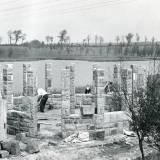
In order to eliminate the negative impact of the soil on the vegetation (the soil at 0.2-0.7 m below ground level is highly podsolic, semi-permeable, sandy clay loam with pH value of 3–4), around 3.5 million cubic metres were relocated and 0.5 million cubic metres of garden soil and peat were added, creating one of the largest urban parks in Europe. The decision to build the park was made in December 1950 by the People’s Provincial Council in Katowice. The idea of converting the devastated post-industrial area into a park came from General Jerzy Ziętek who was subsequently appointed the head of the Construction Committee of the Voivodeship Culture and Leisure Park (WPKiW). The works commenced in July 1951, transforming the spoil tips into a green oasis in the heart of an industrial metropolitan area of Katowice, Chorzów and Siemianowice Śląskie. The Park was a successful attempt to reclaim lands devastated by the industry. One of the first such endeavours in Europe and the largest reclamation project in Poland, it created a unique natural area for the local citizens.
The construction of the Park was a community effort, with thousands of people, from school children to government officials, helping out with the works. State-owned companies provided transport for construction materials and the citizens made donations to fund the project, either directly or by buying special postal stamps, or participating in numerous other fundraising efforts. Taking into consideration the diversity of future functions of the Park, its designer, Professor Władysław Niemirski, used the existing topography of the area, dividing the Park into two zones: one with dense tree stand and shrubbery, intended as a place of relaxation, and the culture and entertainment zone for active leisure enthusiast. He then divided the zones into six further sectors, including the youth sector with a theme park on the site of the old brickworks. He also designed 9 fountains, with the largest one situated in the very heart of the Park.

The culture and entertainment zone sprawled across 113 hectares and included a large dancing circle accompanied by two smaller ones, and a stage where dancing parties and artistic events would take place every evening. In the 1950s, the Park grew rapidly with the construction of the stadium, the zoo, the theme park and the planetarium. In 1957, the first cableway was opened. It was the only lowland cableway in Europe at the time, connecting the theme park and the zoo along a 5 km-long route. Ten years later, the “Elka” cableway was opened. The Park had a total of 70 km of paths and avenues, 2,400 benches, and 850 chairs and deckchairs. In 1962, the Polish Tourist and Sightseeing Society (PTTK) opened its Tourism Centre in the Park which organised and managed tourism in Upper Silesia, working with tourist offices across Poland. One year later, the Scout Centre was opened with an exercise pavilion and a camping site. One of the most successful investment projects was the Water Sports Centre located at the pond which was connected to the Regatta Canal. The Centre rented kayaks and water bikes, and offered motorboat rides. On Sundays and holidays, the Silesian Park would be visited by as many as 150 thousand people. Some visitors would enjoy themselves in the theme park. Others, who were seeking quiet relaxation, would often go to the famous swan house, the Petrych Temple, the Rosarium or the alpine garden, which was later dismantled and replaced by the perennial garden located elsewhere. As intended by its designer, the Silesian Park was a place with something for everyone.
Key dates
December 1950 - the People’s Provincial Council in Katowice decides to create the Voivodeship Culture and Leisure Park (WPKiW).
July 1951 - the construction works in the Park begin.
July 1956 - the Silesian Stadium is completed.
1954 - the construction of the Silesian Zoo begins.
December 1955 - the Silesian Planetarium is opened.
1957 - the construction of the Silesian Theme Park begins.
1957 - the narrow-gauge railway is opened.
July 1961 - the Technological Progress Centre is opened.
15 December 1962 - the PTTK Tourism Centre is opened.
1963 - the first plein air workshop is held (the last took place in 1983). As a result, the Silesian Sculpture Gallery is created.
1963 - the Scout Centre is opened.
12 June 1966 - the “Fala” swimming complex is opened.
7 September 1967 - the “Elka” cableway is launched.
24 June 2968 - the grand opening of the Rosarium.
1968 - the “Hat” Exhibition Centre is opened.
May 1975 - the Upper Silesia Ethnographic Park is opened.
2007 - the Palenisko Adventure Park is opened.








